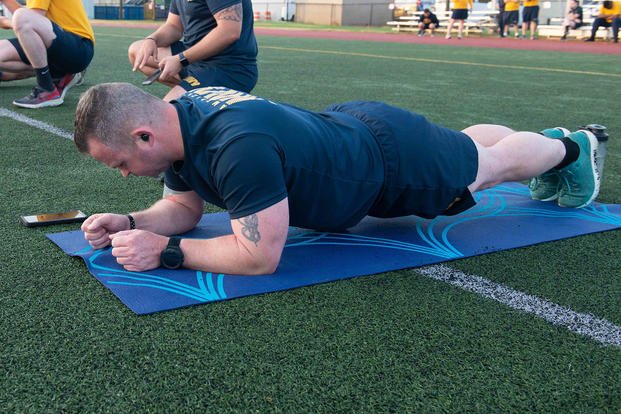Now that the leg tuck is officially no longer part of the Army Combat Fitness Test (ACFT), the only choice that soldiers have is to replace it with plank pose. That means you need to incorporate planking into your training.
The other ACFT events include the deadlift, sprint-drag-carry, standing powerball throw, hand-release (HR) push-ups and the two-mile run. The change means that, instead of doing a very challenging leg tuck, now you get to do a less challenging plank pose.
But that does not mean the plank pose is easy. Planking for several minutes is tough and requires practice. It is a safer exercise than either sit-ups or leg tucks, where a weak grip can cause you to fall off the bar. The beauty of the plank pose option for core stability testing is that it requires no additional grip strength, focusing almost entirely on core alone.
The ACFT Is Here, So Incorporate It into Your Training
The tweaks and changes to Army fitness standards are the result of a long selection process that goes back more than a decade. Remember the changes discussed back in 2011?
This "final'' change was a response to questions about the validity of the leg tuck as a core exercise test. In my opinion, the leg tuck is actually a great core exercise test -- but it also requires grip strength, partial pull-up strength and lower back flexibility. Personally, I still think that a tactical fitness test that evaluates grip makes sense and should be included in some way, perhaps with a hanging test or grip dynamometer.
But if the goal is merely to test core strength and stability, the plank is a good option. Since the deadlift and the sprint-drag-carry also test grip during the ACFT, an exercise that is less grip-dominant like the plank makes sense as part of a testing program that includes multiple exercise events.
Try This Favorite Plank and Push-Up Workout
Master Both the Plank and Hand-Release Push-Up
Try this workout to prepare for both the plank pose and the hand release push-up.
Build up to 10 minutes in the plank position. Every minute on the minute (EMOM), do 5-10 hand-release (HR) push-ups.
This gives you a break from the plank pose, but also challenges your core, push-up ability and shoulder mobility. In fact, the better you are at plank pose, the easier your push-ups will be, since many people will fail at push-ups due to their inability to stay stiff in the push-up position.
Plank Pose Push-Up Pyramid
Check your progress with a workout that is also part assessment tool with the plank pose push-up pyramid.
- 1 minute plank, 1 HR push-up
- 1 minute plank, 2 HR push-ups
- 1 minute plank, 3 HR push-ups ...
Keep going up the pyramid until you either fail to maintain the plank pose or at the push-ups for the timed set every minute on the minute.
Basically, this is also a 10-minute plank pose challenge with an increasing number of push-ups done EMOM. Can you do five minutes for a total of 15 HR push-ups?
Keep practicing on upper body workout days and build up to 10 minutes and a total of 55 push-ups.
If you are looking for group PT challenges, this is a great option. It's much easier to do this pyramid with a group of people who are suffering together.
Grip Work: Other Hanging Options
Working the grip is important. Hanging is one of many ways to develop that strength. Other methods include carrying weight in your hands, rope climbing, doing pull-ups and deadlifting.
If you prefer mixing some grip hanging and core exercises into your training regimen, the leg tuck is still an excellent choice, even if the ACFT doesn't require it. But other variations are excellent tools for core and grip training options.
Consider the kip-up used in the Army Upper Body Round Robin (Spec Ops Test), the CrossFit-style toes-to-bar exercise and the much easier hanging knee-up as a nice variety of exercises to challenge your grip, stretch your body, and work both hips and core.
How Can You Improve Your ACFT Scores?
You need to practice for all of these events. The best thing about the plank pose is that you can practice it throughout the day in 1-2 minutes segments where and when appropriate.
The remaining events of the Army Combat Fitness Test require a specific workout regimen to help build strength, power, speed, agility, grip and endurance. The days of quickly preparing for the now-retired Army Physical Fitness Test (APFT) two weeks prior by practicing more push-ups, sit-ups and running are over.
Building these other elements of fitness will require time in the gym lifting and moving heavy weight to build strength and power. Do not neglect your calisthenics and cardio, as push-ups and running are elements of this test that will suffer if you ignore them during your preparation.
You need a training cycle of 6-12 weeks before taking the official ACFT if you want to perform well.
-- Stew Smith is a former Navy SEAL and fitness author certified as a Strength and Conditioning Specialist (CSCS) with the National Strength and Conditioning Association. Visit his Fitness eBook store if you're looking to start a workout program to create a healthy lifestyle. Send your fitness questions to stew@stewsmith.com.
Want to Learn More About Military Life?
Whether you're thinking of joining the military, looking for fitness and basic training tips, or keeping up with military life and benefits, Military.com has you covered. Subscribe to Military.com to have military news, updates and resources delivered directly to your inbox.


















